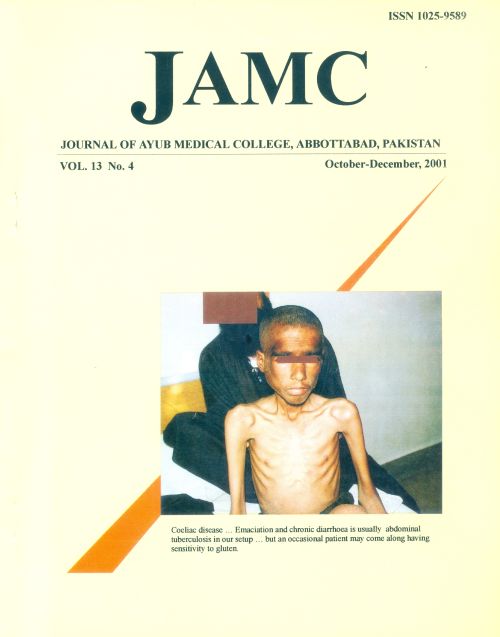CONCENTRATION OF HEAVY METALS IN DRINKING WATER OF DIFFERENT LOCALITIES IN DISTRICT EAST KARACHI
Abstract
Background: Several heavy metals are present in drinking water that play important roles in the body provided theirlevel remains within the specified range recommended by WHO. But now due to the industriali7ation and rapid
urbanization, the problems of pollution have surfaced. This study was designed to ascertain the contents of some heavy
metals and then their variations if any in drinking water in different localities of district East of Karachi, Pakistan.
Methods: Drinking water samples were collected from different sources and localities of district East of Karachi. The
concentration of the heavy metals i.e. Lead, Arsenic. Copper, Iron. Mercury, Chromium, Manganese, Nickel,
Cadmium and Zinc were determined by Atomic Absorption Spectrophotometry. Phi was estimated by pH meter. Total
dissolved solids (TDS) were calculated by formula. These concentrations of heavy metals, pH and TDS were
compared with the standards set by WHO. Results: Concentrations of lead and nickel were found to be significantly
elevated as compared to WHO recommended levels in all the three sources of water (Piped water. Hand pump water
and Tanker water supply). Chromium was found to be raised in hand pump water. Arsenic and Mercury were not
detected in any source of water. Copper, iron, manganese, cadmium and zinc were found to be within the safe limits
in all the three sources of water. pH was found to be within the range of WHO recommended level in all the three
sources of water. TDS was found to be elevated in hand pump water and tanker water. Conclusion: Concentrations
of lead and nickel were found to be significantly elevated as compared to WHO recommended levels in all the three
sources of water in district East of Karachi.
References
Beg MAA. Mahmood NS and Naeem S Pollution due to
tannery diluents in the Korangi industrial area. Karachi. Pak J.
Sci. Ind. Res., 1990 33(10):431 -435.
Campbell, B.C. et al Renal insufficiency associated with
excessive lead exposure. Br. Med. J.,1977 1:482-485.
Chaney, M S. Nutrition 6th ed. Boston. Houghton Mifflin Co.
I960, pp.329-331
Dabeka, R W, McKenzie. A.D., Lacroix. G.M.A. Dietary
intakes of Lead, Cadmium, Arsenic and Fluoride by Canadian
adults: a 24-hour duplicate diet study Food additives and
contaminants 1987 4;89 101.
Fox, B.A. and Cameron, A.G Food Science 2nd ed. University
Press London, 1970. pp 224-230.
Pocock. SJ. et al. Blood lead concentration, blood pressure
and renal function. Br. Med. J. 1984; 289:872-874.
Rahman, A., Gazdar. M.N. and Farooqi, A. (1994) Future
groundwater resources at risk Poster papers of the
international conference, Helsinki, Finland, pp.423-431.
WHO (1996) Guidelines for drinking water quality 2nd
edition, 2:1-6.
Yawer, S.A. (1977) The chemical analysis of drinking water
from various parts of Pakistan. M Phil Thesis, BMSI,
University of Karachi
Downloads
How to Cite
Issue
Section
License
Journal of Ayub Medical College, Abbottabad is an OPEN ACCESS JOURNAL which means that all content is FREELY available without charge to all users whether registered with the journal or not. The work published by J Ayub Med Coll Abbottabad is licensed and distributed under the creative commons License CC BY ND Attribution-NoDerivs. Material printed in this journal is OPEN to access, and are FREE for use in academic and research work with proper citation. J Ayub Med Coll Abbottabad accepts only original material for publication with the understanding that except for abstracts, no part of the data has been published or will be submitted for publication elsewhere before appearing in J Ayub Med Coll Abbottabad. The Editorial Board of J Ayub Med Coll Abbottabad makes every effort to ensure the accuracy and authenticity of material printed in J Ayub Med Coll Abbottabad. However, conclusions and statements expressed are views of the authors and do not reflect the opinion/policy of J Ayub Med Coll Abbottabad or the Editorial Board.
USERS are allowed to read, download, copy, distribute, print, search, or link to the full texts of the articles, or use them for any other lawful purpose, without asking prior permission from the publisher or the author. This is in accordance with the BOAI definition of open access.
AUTHORS retain the rights of free downloading/unlimited e-print of full text and sharing/disseminating the article without any restriction, by any means including twitter, scholarly collaboration networks such as ResearchGate, Academia.eu, and social media sites such as Twitter, LinkedIn, Google Scholar and any other professional or academic networking site.










